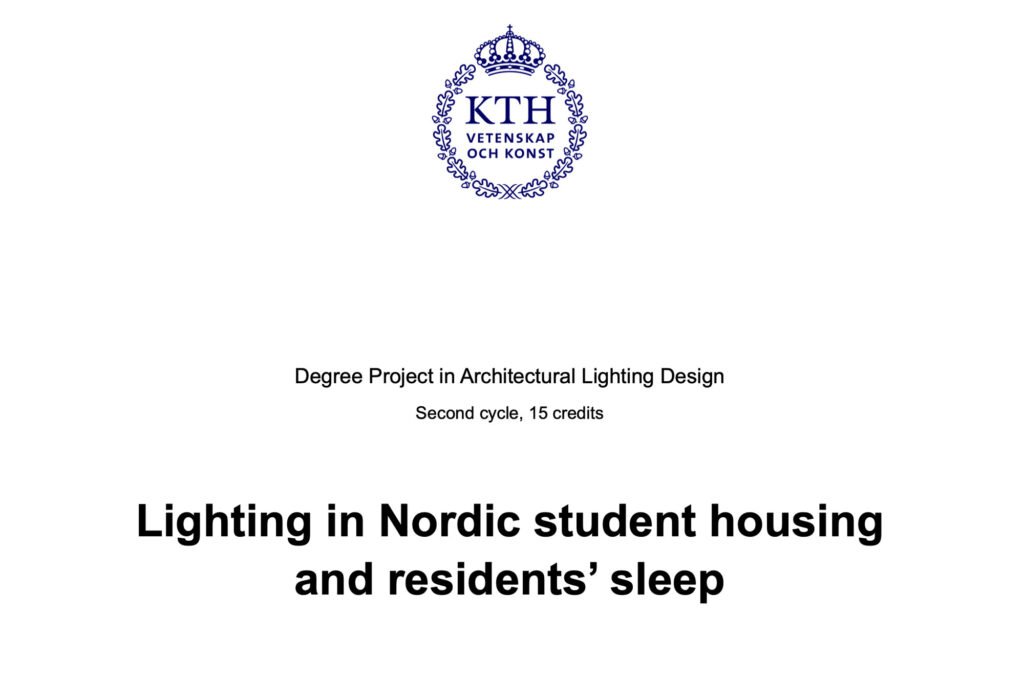This page presents research at the crossroads of light design and perception, focusing on light’s impact on human experience and space. Grounded in a systematic approach, my work explore the psychological and physiological effects of lighting, aiming to enhance both aesthetics and functionality in diverse environments. Through empirical research and theoretical exploration, I seek to uncover how light can optimally be used to improve well-being and influence perception. This platform is a curated collection of my insights and discoveries in the field, reflecting on light’s pivotal role in shaping our experiences.
Lighting in Nordic student housing and residents’ sleep
Degree Project in Architectural Lighting Design, KTH Royal Institute of Technology

Abstract:
Exposure to light relevantly influences human circadian rhythms, affecting not only visual perception but also physical and mental health. This thesis explores the role of architectural lighting on human health and well-being within a controlled Live-in Lab environment, focusing particularly on twilight exposure and its effects on circadian rhythms and sleep patterns. Employing a combination of environmental sensors and sleep diaries, the study quantifies light exposure and investigates its association with sleep disturbances and overall daily well-being.
The findings reveal a notable misalignment between the prevailing lighting conditions and the optimal settings for supporting natural circadian rhythms. This misalignment underscores the necessity for architectural designs that more effectively integrate natural light cycles, particularly in regions with relevant seasonal variations in daylight, such as northern latitudes. Based on these insights, the thesis recommends adopting twilight simulation technologies to enhance sleep quality and better align circadian rhythms with other light patterns that are not naturally synchronized with the extreme conditions in the Nordics.
The research contributes to the field by providing empirical evidence supporting the development of lighting strategies that promote healthier living environments, emphasizing the crucial role of lighting design in enhancing well-being. The recommendations offered aim to guide future architectural practices in creating spaces that not only meet aesthetic and functional requirements but also foster health and sustainability.
Keywords:
Twilight, Sleep Quality, Daytime Well-being, Daylight
Pioneering Architectural Lighting Research: From Thesis to PLEXE Project
While my thesis was developed independently and prior to my knowledge of the PLEXE project, both initiatives are deeply committed to advancing architectural lighting design. My work explored the perceptual, behavioral, and physiological effects of lighting within the innovative environment of the KTH Live-In Lab, providing valuable insights that align with the objectives of PLEXE. This alignment underscores the importance of foundational research in setting the stage for larger projects. The PLEXE project, conceptualized and proposed by Ken Appleman, Davide Rolando, and Prof. Ute Besenecker in 2023, secured an initial funding of nearly 3 million SEK in June 2024. It aims to expand the infrastructure of the Live-In Lab to enable advanced lighting studies in residential spaces. Together, these efforts highlight the significant impact and growing relevance of research in architectural lighting design.
Gray Papers
Selected writings from my tenure at KTH during the Master of Science in Architectural Lighting Design
A primary constant of the Universe, 2023
Chromalens: Redefining Colour Perception, 2023
The role of light in shaping the imaginative city, 2023
Design for Darkness: Reevaluating Well-Lit Cities, Dark-Skies and Wilderness Environments, 2023